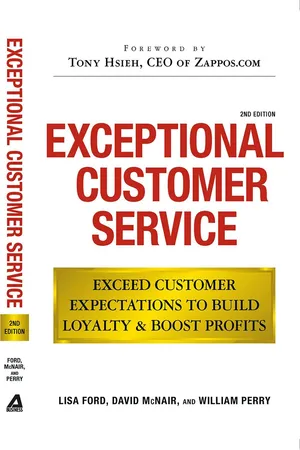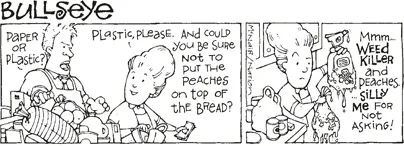![]()
Ten
Customer Feedback: Are You Hungry?
There is only one rule here. The customer defines your service. Did you get that? The customer DEFINES your service! It sounds simple, logical. Then why do so many service providers operate as if they define the service? Why do they fail to ask the simple questions, “How are we doing?” “Are you pleased with our products and/or services?” “What else can we do for you?” “Will you come back to see us again?” And, the most significant question, “Would you refer a friend or family member to our business?”
I have talked to countless business owners, executives, and frontline associates who say, “We have a good feel for our customers. We just don't get that many calls, letters, or comments. And management sees every one we do get so that we can keep in touch.” Keep in touch! Give me a break. That's like waiting for a plant to die in order to say, “I guess it needed water.”
Note to team members
Getting customer feedback is seen too often as a management responsibility. Isn't it their job to develop customer satisfaction measures? Don't get caught in that trap. You are the eyes and ears to the customer. You see them across the counters, down the aisles, or hear their voices directly on the telephone. You have a great deal of input to offer, so read on and see what you can do. Help turn this type of informal feedback into a more formal system.
Numerous studies over the last several years have reported consistently that only 2 to 5 percent (depending on your industry) of your customers complain voluntarily. This is not 2 to 5 percent of your total customer base. This is 2 to 5 percent of the unhappy customers, the “I had an unsatisfactory (I may not return) experience” customers. So for every letter or phone call you receive from an unhappy customer, picture another ninety-six walking out without saying a word.
In today's busy, demand-upon-demand kind of world, you have to actively solicit your customers' impressions (the good and bad). And you must do it in a creative, nonintrusive, easy-to-obtain way. Once you have the feedback, you must do something with it. Not next quarter, next year, or next decade, but now.
A good guide to follow is the A, B, C, D method:
A sk for feedback
B elieve what they're telling you
C ommunicate your results
D o something with what you've learned
A =Ask for Feedback
Asking for customer feedback may be formal or informal. It can be in person, by mail, by phone, by e-mail, or by website. It can be conversational or statistical. What's important is that you seek it.
The hotel industry is skilled at getting feedback. One major urban hotel has a program called Elevator Ears. That pretty much says it. At this hotel, employees are riding up and down the elevators all day long with customers. In fact, they are encouraged to do so. But these employees are trained not to think of the elevator as a way of getting from floor 2 to floor 12. They are trained to think of it as an opportunity to hear from their guests. It's an amazingly simple way to gather information from a somewhat captured audience. And you hear it all: guests who just registered, a couple from the restaurant, a businesswoman from the seminar, a golfer, a swimmer, and maybe even a late sleeper. The fact is, these are the people using the hotel services, and they often have comments. Many times these comments are volunteered without asking. Haven't you taken that moment of reflection in an elevator to say, “Boy, am I ready to get to the room. I thought we'd never get checked in.” or “I guess that waitress was having a bad day.” Or perhaps you've made a comment on the parking garage or the smell of smoke in the hallways.
Employees at this hotel are also trained to initiate a conversation if they do not hear one. “How is everyone this morning? I hope you're enjoying your stay at our hotel.” And if that doesn't kick it off, the employee may add, “Has anyone tried our restaurant this morning?” or “I see you've been to the health club, how did you find our services there?” Can you just imagine the impression this makes!
W Hotels, Starwood's chic hotel brand, also has coached its employees to listen for clues that will help anticipate guests' needs. Complain to your husband on your cell phone about a sore throat while you're standing at the check-in desk, and W employees might send up a cup of chicken soup gratis.
One of the things I like best about the Elevator Ears program is that it's not just for hotels. You can take the same principles of employee training for feedback and apply them to hospitals, retail stores, banks, and even doctors' offices. It's a matter of training employees to listen and to report. Can you think of listening posts for your business? A listening post can be any location where easy dialogue can take place — hallways, waiting rooms, around counters, throughout restaurants, most any public place.
Name three “listening posts” in your organization.
As a team, can you determine a simple but effective way to share comments from your listening post? Suggestion: Give each team member the challenge of recording three observations in a week and then set aside ten minutes at a team meeting to share the observations. Develop a simple table, and keep a record of the types of comments that you hear. This will help you track any problem areas or items needing attention.
So Who's Asking Whom?
Let's talk a moment about whom we survey for service feedback. Is it:
the purchaser of our product or service?
family or friends of the purchaser?
the end user of our product or service?
a former or “lost” customer?
our vendors/suppliers?
our employees?
A hospital illustrates how difficult it can be to define your customer. The most obvious customer in a hospital is the patient. And certainly the patient is important. But did the patient admit himself/herself, or did a doctor direct them to the hospital? Oh, so the doctor is really the important customer. Did the doctor choose the hospital based on services, or was he or she directed by the insurance provider? I see, so now it's the insurance provider. Did the doctor have several choices, and did the physician's staff have influence regarding the hospital they work best with? Did the patient's employer select the health plan, and how did they choose participating hospitals and physicians in their plan? It gets complex doesn't it?
One of the forgotten groups of customers to survey is those who once did business with you but are now doing business with the competition. What made them leave? What is the competition doing better? Is there a way to recover their business? By surveying this group of folks you not only learn a great deal about your service potholes, but your last message to the former customer is that you care! Wouldn't you prefer that this follow-up be the last impression with the customer as opposed to the bitter taste they carry from the poor service that drove them away?
Note to team leader
An automobile service shop trained its driver for the shuttle bus to solicit questions and debrief customers. “What do you think of our service shop? How friendly were the folks taking your order? Would you recommend us to your friends and neighbors?” Think for a moment. Have you adequately trained everyone who has contact with your customers?
Another effective feedback method involves the use of “lost job” questionnaires. These questionnaires are sent to prospective customers. They are especially useful for companies involved with contracting bids and technical proposals. I remember an article in Inc. magazine years ago that featured T&K Roofing, a contractor in Iowa who used a very effective lost job survey. Many companies believe that they lose bids based solely on price. T&K discovered this not to be true. They found that many of their bids were lost due to other reasons such as followthrough, sales rep inexperience, or lack of knowledge. They gained great insight from their surveys, which helped them to grow despite eight new competitors in their marketplace. Following is the T&K survey questionnaire:
T&K Roofing Company Inc.
At T&K Roofing Company, our number one priority is to provide and deliver goods and services that our clients want and value. By completing this evaluation, you will assist us in assessing why we did not meet your requirements.
Please identify the following items that affected your decision NOT to accept our bid. Please feel free to be completely honest. Your feedback is very important to us, and your responses will remain confidential.
Thank you for your assistance,
Thomas M. Tjelmeland, President
Were any of the following a major factor in your decision NOT to award the contract to T&K?
1. Price | Yes | No |
2. T&K reputation (integrity) | Yes | No |
3. Service Offerings | Yes | No |
4. Available warranty | Yes | No |
5. T&K location | Yes | No |
6. Project schedule | Yes | No |
7. Roof system requirements | Yes | No |
8. Billing terms | Yes | No |
9. Established relationship with another contractor | Yes | No |
10. Please list the main reasons T&K was not selected: | | |
11. (optional) Can you tell us who was awarded the contract? | | |
12. If price was the reason for losing the business, can you tell us by what percentage T&K was higher than the selected contractor? | | |
13. If service offerings and/or capabilities affected the selection, what did T&K not offer that the competition did? | | |
14. If your project is rebid at a later date, would you like us to contact you again? When? | | |
Please rate the effectiveness of the presentation made by our sales representative (1 =lowest rating, 10 =highest rating). This information will be kept confidential from the representative.
15. Receptiveness and understanding of the project requirements and the needs of your firm. | 1 2 3 4 5 6 7 8 9 10 |
16. Presentation of T&K Roofing's capabilities, products, service offerings, and recognitions. | 1 2 3 4 5 6 7 8 9 10 |
18. Willingness and ability to answer all of your questions. | 1 2 3 4 5 6 7 8 9 10 |
1... |




